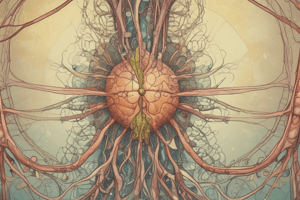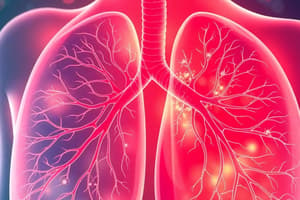Podcast
Questions and Answers
What is the primary neurotransmitter used by sympathetic postganglionic neurons?
What is the primary neurotransmitter used by sympathetic postganglionic neurons?
- Noradrenaline (correct)
- Dopamine
- Acetylcholine
- Serotonin
Which category do drugs that enhance the effect of noradrenaline fall into?
Which category do drugs that enhance the effect of noradrenaline fall into?
- NAT inhibitors
- Adrenergic antagonists
- Muscarinic agonists
- Adrenergic agonists (correct)
Which of the following is an example of a β-adrenoceptor antagonist?
Which of the following is an example of a β-adrenoceptor antagonist?
- Dopamine
- Isoprenaline
- Metoprolol (correct)
- Phenylephrine
How are adrenoceptors primarily categorized?
How are adrenoceptors primarily categorized?
Which type of drug acts on the sympathetic nervous system via catecholamine regulation?
Which type of drug acts on the sympathetic nervous system via catecholamine regulation?
What is the mechanism of action for α-adrenoceptor agonists?
What is the mechanism of action for α-adrenoceptor agonists?
What distinguishes β-adrenoceptor antagonists from α-adrenoceptor antagonists?
What distinguishes β-adrenoceptor antagonists from α-adrenoceptor antagonists?
Which of the following is a primary use for muscarinic antagonists?
Which of the following is a primary use for muscarinic antagonists?
Which class of drugs primarily contains NAT inhibitors?
Which class of drugs primarily contains NAT inhibitors?
What is the primary role of MAO inhibitors in relation to noradrenaline?
What is the primary role of MAO inhibitors in relation to noradrenaline?
What is the primary structural difference between nicotinic ACh receptors in skeletal muscle and those in the autonomic nervous system?
What is the primary structural difference between nicotinic ACh receptors in skeletal muscle and those in the autonomic nervous system?
Which drug is recognized as a non-competitive antagonist of autonomic nicotinic ACh receptors?
Which drug is recognized as a non-competitive antagonist of autonomic nicotinic ACh receptors?
What type of receptors do postganglionic neurones of the parasympathetic nervous system predominantly act upon?
What type of receptors do postganglionic neurones of the parasympathetic nervous system predominantly act upon?
What is a prominent effect of muscarine poisoning?
What is a prominent effect of muscarine poisoning?
How does atropine counteract muscarine poisoning?
How does atropine counteract muscarine poisoning?
What is the therapeutic use of pilocarpine?
What is the therapeutic use of pilocarpine?
Which aspect of hexamethonium limits its clinical use?
Which aspect of hexamethonium limits its clinical use?
What type of receptor is primarily targeted by muscarinic agonists?
What type of receptor is primarily targeted by muscarinic agonists?
Which of the following is NOT an effect associated with muscarinic stimulation?
Which of the following is NOT an effect associated with muscarinic stimulation?
Which statement about muscarinic ACh receptors is incorrect?
Which statement about muscarinic ACh receptors is incorrect?
Flashcards
Nicotinic ACh Receptor (nAChR)
Nicotinic ACh Receptor (nAChR)
A type of acetylcholine receptor found at the junction between preganglionic and postganglionic neurons in both the sympathetic and parasympathetic nervous systems.
Hexamethonium
Hexamethonium
A non-competitive antagonist of nicotinic ACh receptors in the autonomic nervous system. It blocks all the effects of autonomic stimulation, both sympathetic and parasympathetic.
Muscarinic ACh Receptor (mAChR)
Muscarinic ACh Receptor (mAChR)
A type of acetylcholine receptor found on postganglionic neurons in the parasympathetic nervous system. These receptors are responsible for mediating the effects of the parasympathetic nervous system.
Muscarinic Agonists
Muscarinic Agonists
Signup and view all the flashcards
Muscarine poisoning
Muscarine poisoning
Signup and view all the flashcards
Atropine
Atropine
Signup and view all the flashcards
Pilocarpine
Pilocarpine
Signup and view all the flashcards
Autonomic pharmacology
Autonomic pharmacology
Signup and view all the flashcards
Autonomic drugs
Autonomic drugs
Signup and view all the flashcards
Sympathetic Nervous System
Sympathetic Nervous System
Signup and view all the flashcards
Muscarinic Antagonists
Muscarinic Antagonists
Signup and view all the flashcards
Muscarinic Agonists and ACh Esterase Inhibitors
Muscarinic Agonists and ACh Esterase Inhibitors
Signup and view all the flashcards
Adrenoceptors
Adrenoceptors
Signup and view all the flashcards
Adrenergic Agonists
Adrenergic Agonists
Signup and view all the flashcards
Adrenergic Antagonists
Adrenergic Antagonists
Signup and view all the flashcards
α-Adrenoceptor Agonists
α-Adrenoceptor Agonists
Signup and view all the flashcards
α-Adrenoceptor Antagonists
α-Adrenoceptor Antagonists
Signup and view all the flashcards
β-Adrenoceptor Agonists
β-Adrenoceptor Agonists
Signup and view all the flashcards
β-Adrenoceptor Antagonists
β-Adrenoceptor Antagonists
Signup and view all the flashcards
NAT Inhibitors
NAT Inhibitors
Signup and view all the flashcards
Study Notes
Autonomic Pharmacology
- Drugs targeting the entire autonomic nervous system affect both sympathetic and parasympathetic systems.
- Nicotinic ACh receptors are present at synapses between pre- and post-ganglionic neurons in both systems.
- Skeletal muscle AChRs are pentameric, while ANS AChRs have 2-7 subunits.
- Hexamethonium is a non-competitive antagonist of nicotinic AChRs. It blocks all autonomic effects, but has many side effects.
Drugs Targeting Parasympathetic Nervous System
- Postganglionic parasympathetic neurons use muscarinic ACh receptors to affect organs.
- Muscarinic ACh receptors are G-protein coupled receptors (7 transmembrane domains).
- Five types of muscarinic receptors exist (M1-M5).
- M1 receptors are in the stomach and salivary glands (Gq).
- M2 receptors are in cardiac muscle (Gi).
- M3 receptors are in smooth muscles and glands (Gq).
Muscarinic Agonists/Parasympathomimetics
- These drugs activate muscarinic receptors, mimicking parasympathetic stimulation.
- Effects include decreased heart rate, vasodilation, smooth muscle contraction (gut/respiratory), salivation, and tearing.
Muscarinic Antagonists
- These drugs block muscarinic receptors, opposing parasympathetic effects.
- Uses include asthma treatment (ipratropium/tiotropium), increasing heart rate, widening pupils, treating bladder issues, and motion sickness.
- Pilocarpine is an example and is used in glaucoma treatment.
Drugs Targeting Sympathetic Nervous System
- Sympathetic postganglionic neurons use noradrenaline (NA).
- Adrenoceptors are G-protein coupled receptors (5 types).
- α1 receptors cause smooth muscle contraction (vasoconstriction, etc.).
- α2 receptors also cause contraction and inhibit NA release.
- β1 receptors increase heart rate and contractility.
- β2 receptors relax smooth muscle (e.g., bronchi, blood vessels).
- β3 receptors stimulate lipolysis and relax smooth muscle (e.g., bladder).
Adrenoceptor Agonists (Sympathomimetics)
- Used in vasoconstriction, nasal decongestion, hypertension treatment, and facial erythema.
Adrenoceptor Antagonists (Alpha-blockers)
- Used in hypertension and benign prostatic hyperplasia.
β-Adrenoceptor Antagonists (Beta-blockers)
- Used in angina, cardiac arrhythmias, heart failure, hypertension, anxiety and glaucoma.
Drugs Affecting Catecholamine Regulation
- Noradrenaline (NA) is synthesized from tyrosine.
- NA is stored in vesicles and released in the synapse.
- The action of NA is terminated by reuptake via the Noradrenaline transporter (NAT).
- Some NA is broken down by monoamine oxidase (MAO).
NAT Inhibitors
- Inhibit noradrenaline reuptake to increase its effect on the synapse.
- Examples include desipramine and cocaine.
MAO Inhibitors
- Inhibit the breakdown of noradrenaline, increasing its levels.
- Side effects include hypotension, weight gain, restlessness, insomnia and 'cheese reaction' (hypertensive crisis with cheese).
Sympathetic Amines
- Structurally similar to NA, they are transported into neurons, displacing NA and causing similar effects.
- Examples include amphetamines, ephedrine, tyramine.
Studying That Suits You
Use AI to generate personalized quizzes and flashcards to suit your learning preferences.
Related Documents
Description
Test your knowledge on autonomic pharmacology, focusing on drugs impacting the sympathetic and parasympathetic nervous systems. This quiz includes information about nicotinic and muscarinic receptors, their functions, and the drugs that affect them. Understand the mechanisms of action and clinical implications of various autonomic drugs.




